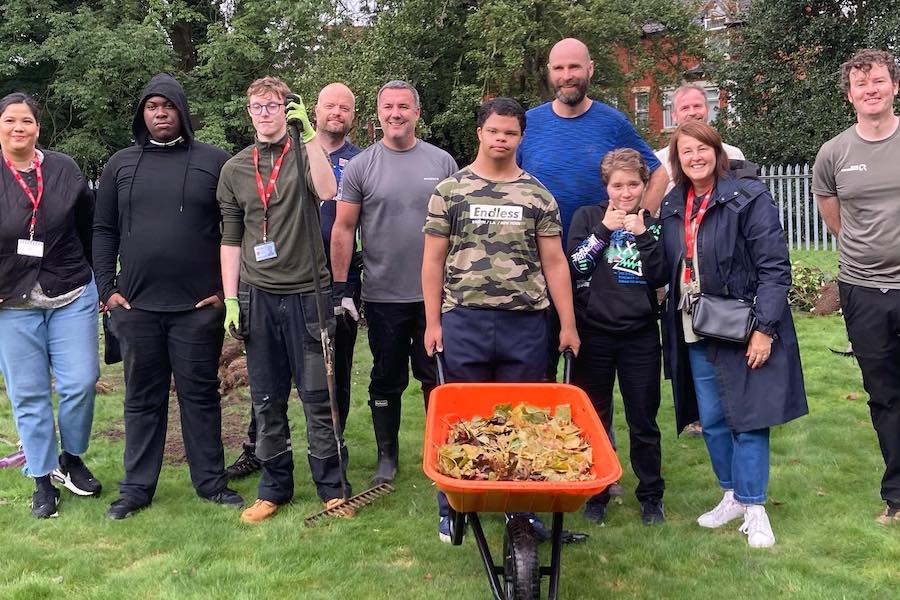On a bright autumn morning, the River Medlock glitters where it winds its way through Mayfield Park. Children race across stepping-stones, office workers sip takeaway coffees by the water’s edge, and a pair of ducks dabble lazily in the shallows.
It’s hard to believe that just a few years ago, this spot was a derelict culvert of concrete, hidden from view for more than half a century. Today, it’s Manchester’s newest city-centre park, the first in a hundred years, and a symbol of the city’s determination to bring nature back into daily life.
Castlefield Viaduct and Mayfield Park – Manchester’s headline green spaces
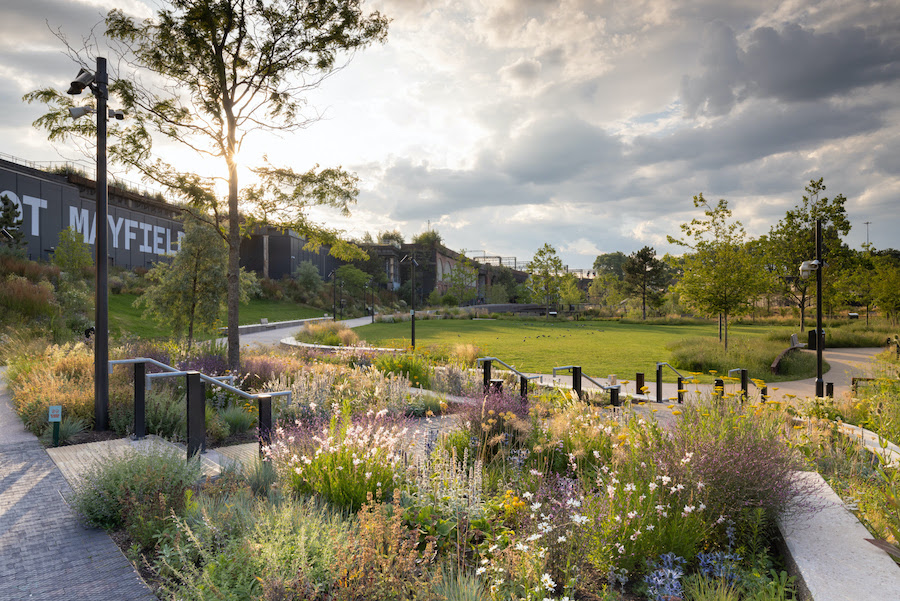 Mayfield Park, Manchester.
Mayfield Park, Manchester.
Castlefield Viaduct has been a smash hit with residents, transforming a forgotten piece of Victorian infrastructure into a suspended park of greenery, calm, and sweeping views. Now, Phase 2 will extend it from 150 to over 350 metres, making it one of the UK’s most ambitious regeneration projects.
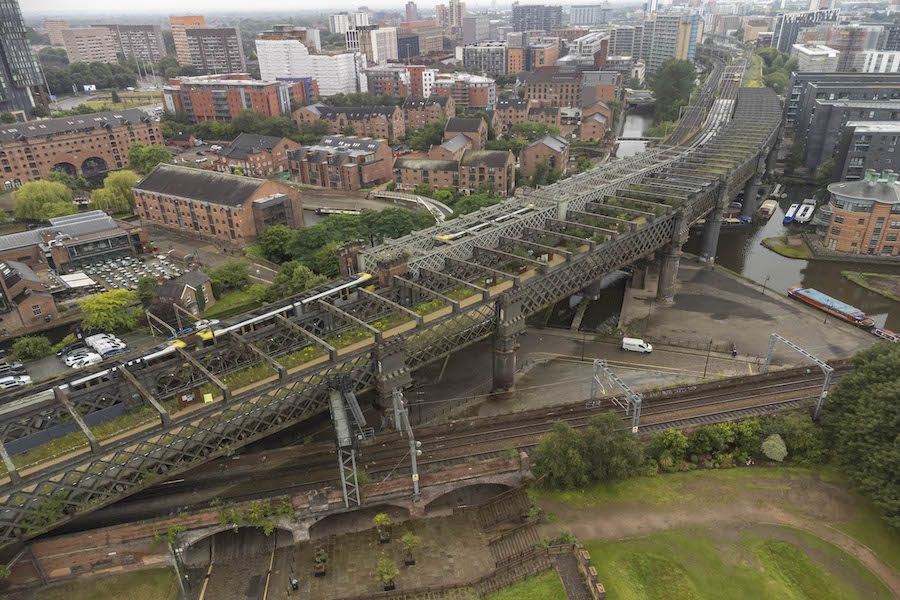 The Castlefield Viaduct has been a huge success
The Castlefield Viaduct has been a huge success
Mike Innerdale, Regional Director for the North at the National Trust, called it “iconic of the things we want to see in Manchester. It’s about creating a park in the sky, a place that connects communities.”
He stressed it’s not only a beauty spot, but it’s also an essential part of life in a modern city. “We’re surrounded by high-rises and new developments, but we’re not always designing the green spaces people desperately need. This isn’t a luxury, it’s essential. This is about prosperity, health, and creating a city that works for people and for nature.”
Community involvement has been key. Castlefield Forum has worked with the National Trust from the outset, shaping the design and ethos.
Forum member Jane Black said, “People generally love it. We’ve kept our members involved from day one, and many have helped shape the community plots you pass along the walk. This isn’t just a showpiece. It’s becoming part of daily life.”
She added: “Phase 2 will bring even more opportunities: imagine walking your dog, commuting to work, or just taking a moment to breathe in some calm, right here above the city.”
Black, who helped lead the Phase 2 design group, hopes the new section will serve as both garden and green lung: “With so many people in apartments and flats, these spaces aren’t just desirable, they’re vital. This is about health, happiness, and giving the city room to breathe.”
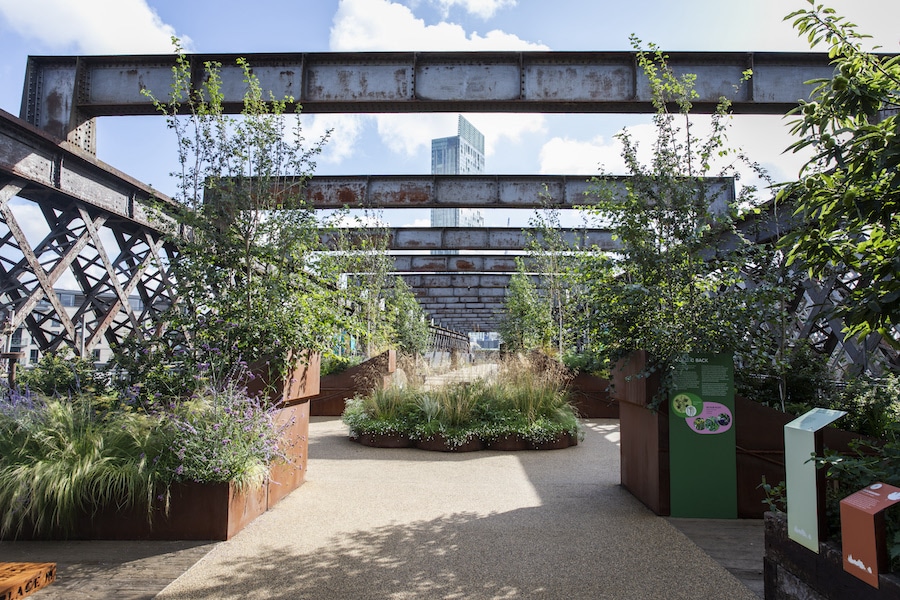 Castlefield Viaduct, National Trust Images. Credit: Annapurna Mellor
Castlefield Viaduct, National Trust Images. Credit: Annapurna Mellor
But if Mayfield Park and the Castlefield Viaduct sky garden are the headline-grabbing projects of Manchester’s green revival, the real renaissance is taking root at a much smaller scale. In ginnels, disused orchards, car parks, and neglected patches of scrub, communities across Greater Manchester are reinventing their neighbourhoods from the ground up.
What is the Local Nature Recovery Strategy (LNRS)
Their work is captured in the Local Nature Recovery Strategy (LNRS), Greater Manchester’s ten-year plan for biodiversity and habitats. The strategy recognises the urgency of the crisis: “Globally, nationally and locally we are witnessing a continued decline in our wildlife populations,” it warns, with one in six UK species now threatened with extinction. But it also celebrates how councils, campaigners, and above all, communities are already reshaping the city.
What emerges is a story not just of policy or parks, but of people: residents who refuse to accept neglect, volunteers who turn waste ground into flourishing gardens, and neighbours who discover new connections through the act of growing food together.
It’s not all grey in Manchester….
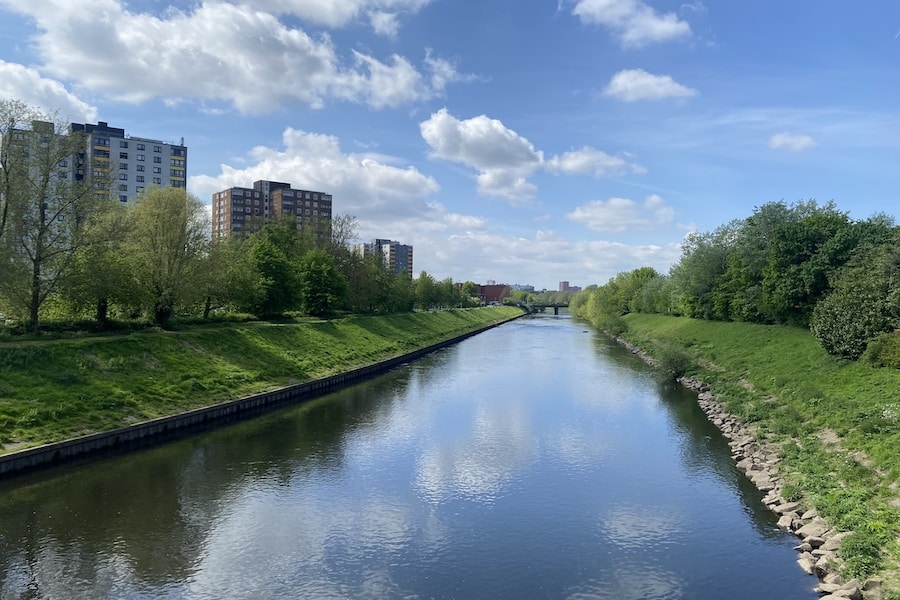 The beautiful River Irwell
The beautiful River Irwell
Manchester’s relationship with nature has always been complex. It was rivers, the Irwell, Medlock, Irk, and the great ship canal, that powered its rise as the “workshop of the world.” But by the mid-20th century, those same waterways had become dumping grounds, poisoned by industrial effluent and sewage. The Mersey was once described as biologically dead.
The industrial city also built itself over much of its open land. In some neighbourhoods today, one in five households has no access to a private or shared garden. The LNRS estimates that a third of Greater Manchester’s residents cannot reach a decent-sized green space within 15 minutes.
For wealthier suburbs, nature is often close at hand. But in inner-city districts like Moss Side, Longsight, Newton Heath, or Oldham, green space has historically been scarce, neglected, or unevenly distributed. And yet it is here, precisely where the need is greatest, that some of the most inventive community-led projects are flourishing.
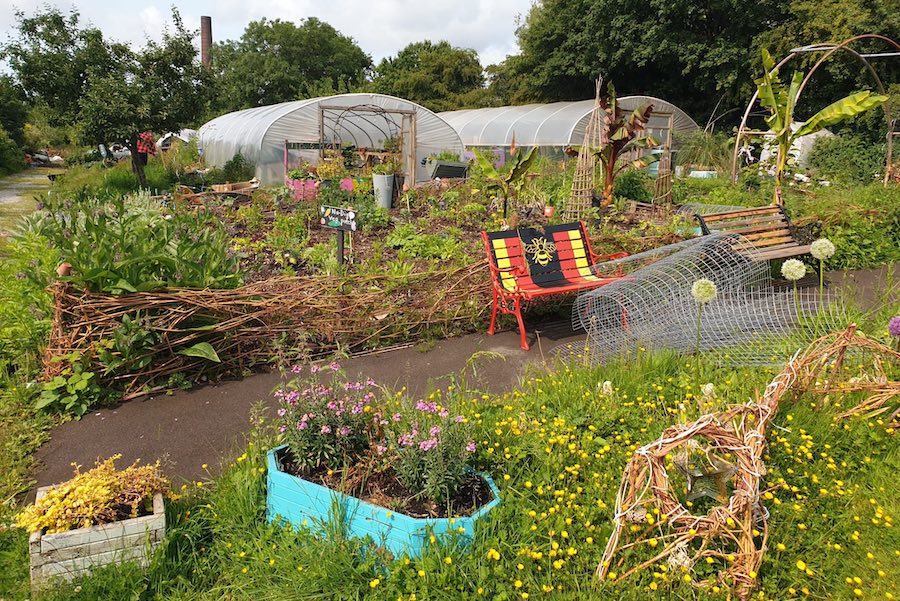 A place to relax and unwind
A place to relax and unwind
When Victoria Holden first visited the locked-up orchard in Failsworth, she was struck by the sense of wasted potential. Behind the gates lay 166 fruit trees, their apples and pears falling uncollected year after year. A once-busy community centre was crumbling, weeds ran rampant, and an acre of land was slowly rotting away.
“We couldn’t just let this go to waste,” she recalled. After eight months of negotiations, Oldham Council agreed to let her group take it on. That was the beginning of the Northern Lily GROWE Community Garden.
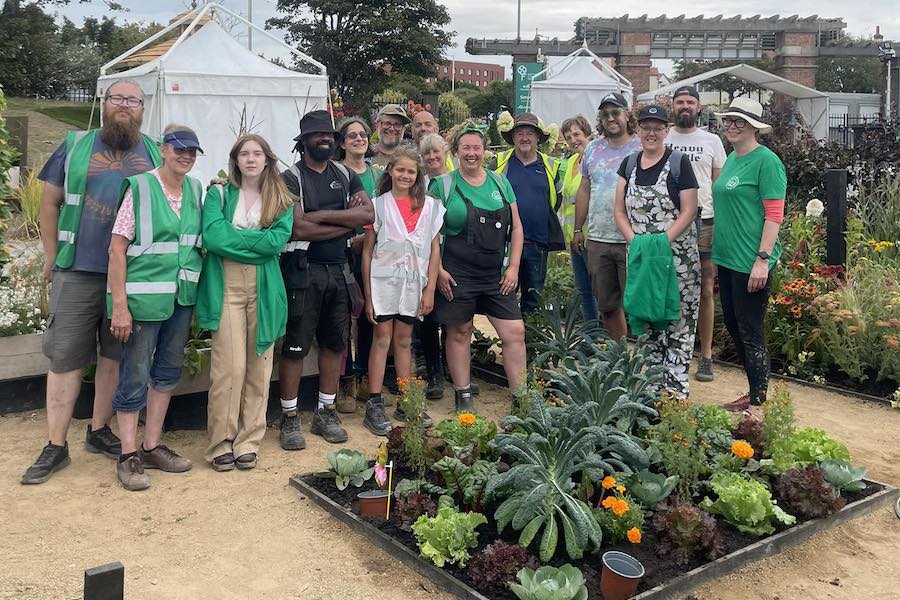 The amazing Northern Lily volunteers
The amazing Northern Lily volunteers
Today, three years on, the site hums with activity. What began with rescuing apples for jam has grown into a multi-layered community enterprise. A bike library allows families without access to cycles to borrow them for free. A local beekeeper works with schools, teaching children the role of pollinators. Volunteers receive training in horticulture and orchard care. On the Rochdale Canal, which runs alongside the site, monthly paddle-sport litter picks clear debris while engaging young people in river stewardship.
And then there is the food. In just one season, the garden produced over a ton of fruit and vegetables, the equivalent of more than 12,000 meals. Weekly harvest days bring residents together to pick, cook, and eat. Plans are underway for a community kitchen where a nutritionist will run workshops on healthy cooking and food preservation.
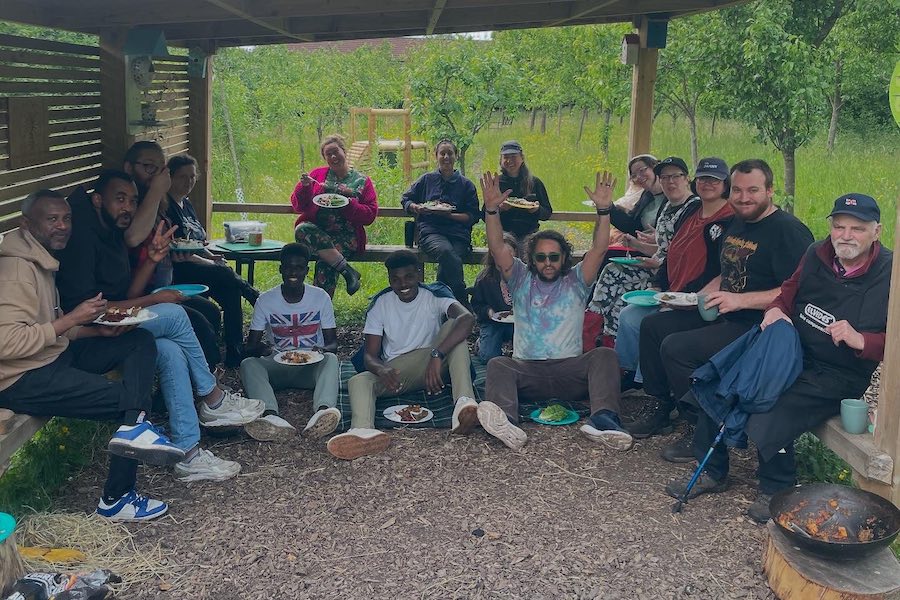 Northern Lily volunteers
Northern Lily volunteers
The impact has been profound. Around 4,000 people now use the site each year, from asylum seekers and refugees to families, older residents, and young people. Parents often arrive expecting resistance from their children, only to watch them try plums or pears for the first time, run among the trees, and beg not to go home. For families with disabled children, the orchard has become a lifeline: a safe, open, stimulating space where their kids can flourish.
Victoria is clear about what lies at the heart of the project. “Food and gardening bring people together. It creates real social energy.”
Recognition has followed. In 2023, the garden won the Soil Association’s Organic in Communities national award, adding to a growing list of honours. But for Victoria, the true achievement is social connection. “We’ve created a safe, inclusive space where people meet across cultures and backgrounds. That’s what breaks down stereotypes, not reading about people in the news, but meeting them for real.”
You can find out more about the award by clicking here
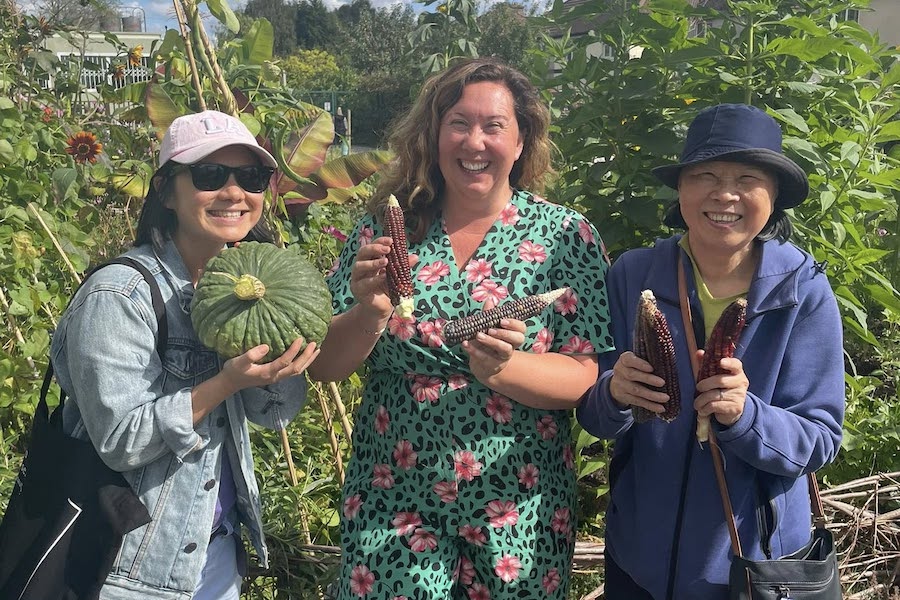 Victoria (centre) with two volunteers
Victoria (centre) with two volunteers
The orchard has also become part of the LNRS in practice, not just in principle. Floating plant islands in the canal provide habitats for fish and invertebrates. Pollinator patches increase biodiversity. Plans for a “Fruit Route” connecting the town hall to the orchard aim to stitch community spaces along the waterway.
For Victoria, projects like hers point to a wider issue: access to land. She backs the Right to Grow campaign, which calls on councils to give communities legal rights to cultivate unused public land. So far, only Bury in Greater Manchester has adopted it. “It’s a win-win-win,” she insists. “Landowners get their sites improved, nature gets habitats, and communities get free services.”
What began as a forgotten orchard is now a model of grassroots regeneration, not just a place of cultivation, but of connection with neighbours and the wider community.
Upping It: greening the ginnels of Moss Side
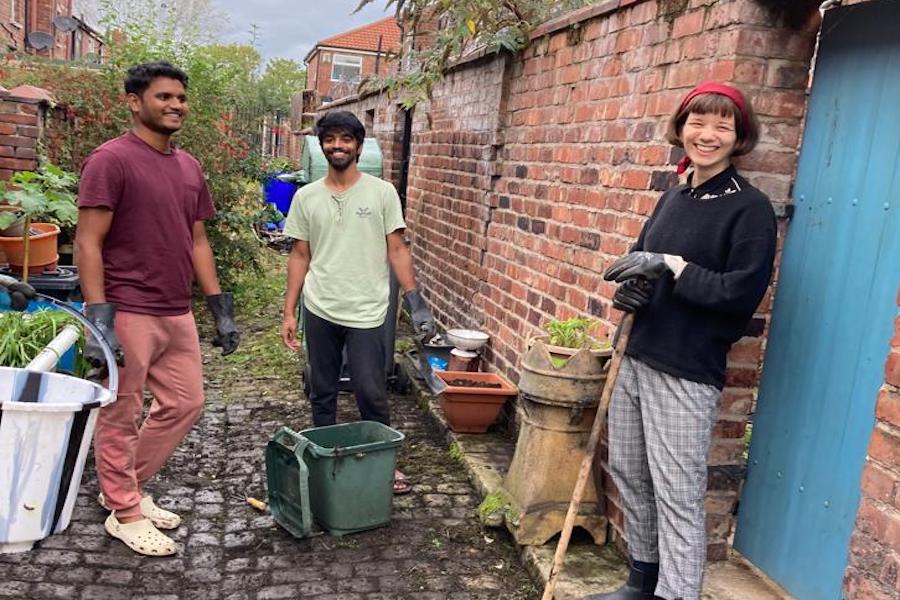 The upping it volunteers taking pride in their neighbourhood
The upping it volunteers taking pride in their neighbourhood
If Norhtern Lily is about orchards, Moss Side’s Upping It is about alleys. In 2013, Anne and her neighbours began discussing waste and recycling. Their concern was simple: fly-tipping and litter were blighting their streets. But the conversations sparked something bigger.
Over the next decade, Upping It transformed Moss Side’s ginnels, the narrow alleyways between terraces, from neglected dumping grounds into green, communal spaces. Out went rubbish and dereliction; in came planters, flowers, murals, and play zones where children gather safely.
“The alleys were overlooked, but people wanted to reclaim them,” Anne explained. “It was about making them green and making them loved.”
The transformation was social as much as physical. Recycling rates rose, waste fell, and neighbours who had barely spoken began to connect. WhatsApp groups now link residents, strengthening support networks. Composting schemes turn food scraps into soil, teaching children how yesterday’s waste can feed tomorrow’s flowers.
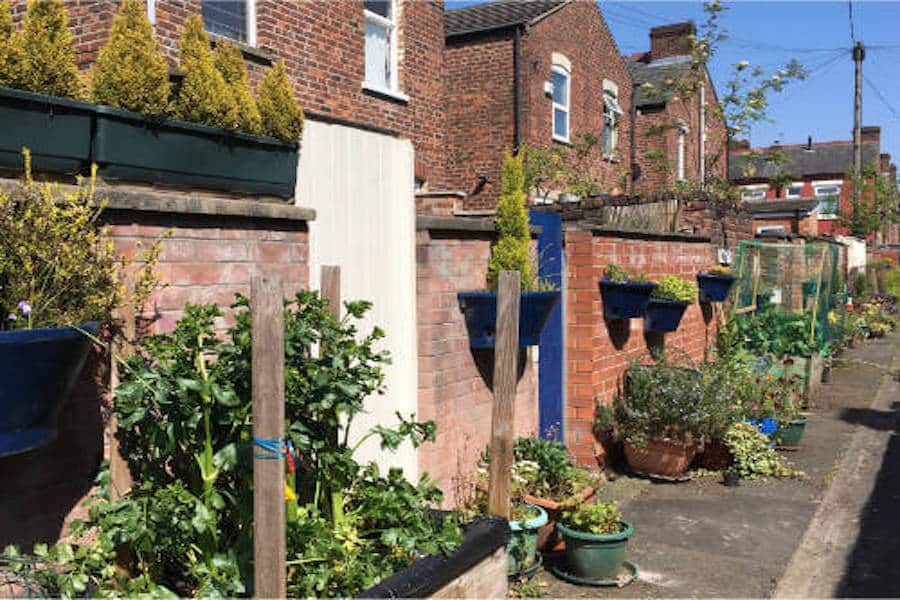 Looking good!
Looking good!
The challenges were real. Heatwaves threatened to wither the new greenery. Water butts and hoses were installed to keep plants alive. Theft and vandalism tested morale. Even knives were found discarded. But community spirit kept the project alive.
For Anne, the deepest impact is pride. “We’re creating communal gardens, and therefore neighbours who can share things with each other. That’s what I’m most proud of.”
Their work has also reached the city’s cultural stage. In 2018, Upping It collaborated with University of Manchester researcher Sherilyn MacGregor on Talking Rubbish in Moss Side, exploring residents’ experiences of waste. The project culminated in Rubbish Night at the Museum, an exhibition at Manchester Museum that dramatised residents’ words. It drew record crowds and gave recognition to voices too often ignored.
How Sow the City are help communities build green spaces
While Mayfield Park and the Castlefield Viaduct symbolise Manchester’s green ambitions, another small scale revolution is happening in community gardens and allotments. Here, food is at the centre, a powerful way to connect people with each other and with the land.
 Kieron from Sow the City
Kieron from Sow the City
Sow the City, founded in 2009, has been central to this movement. Director Kieron McGlasson summarises their philosophy: “If children grow something, they’re more likely to eat it. Tomatoes, sweetcorn, fruit.
“Our mission is to create green spaces in urban places, so often we will get a call from a community group or local people who say, there’s a neglected piece of community ground we’d like to turn into a community garden or green space. We help with that.”
Sow the City supports communities to transform derelict land into thriving gardens, providing expertise on funding, volunteers, and workshops. Their focus is strongest in deprived areas where access to green space and healthy food is limited. “The stereotype that people in poorer areas only want fast food isn’t true,” Kieron said. “What communities want is access to fresh food, positive activities, and spaces where everyone can come together.”
The results are visible across the city. These are just a few of the amazing projects that Sow the City has helped turn from a desolate piece of land into a thriving community asset.
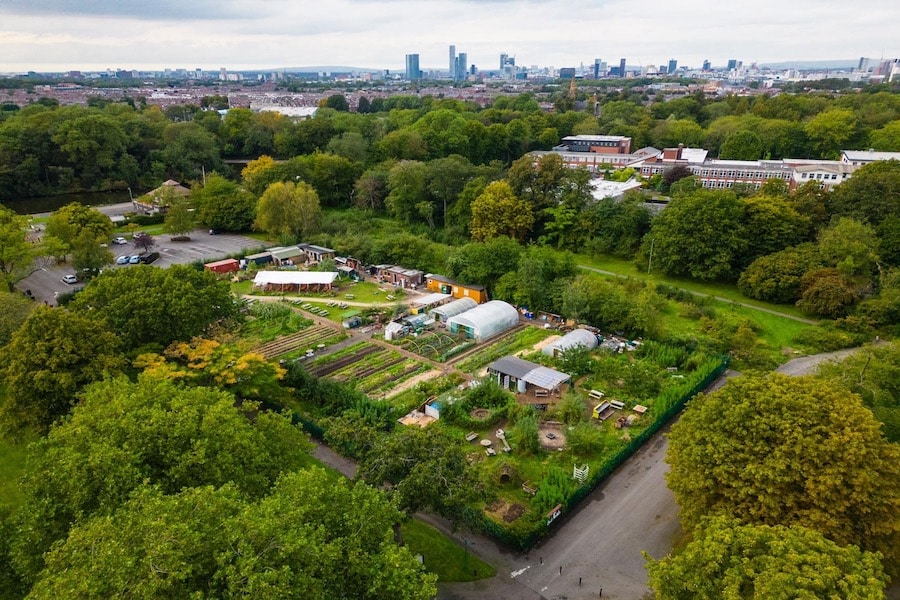 Manchester Urban Diggers at Platt Field Gardens
Manchester Urban Diggers at Platt Field Gardens
Manchester Urban Diggers (MUD) began in 2019 with Platt Fields Market Garden and has since expanded. Their sites combine food growing with wellbeing programmes and therapeutic horticulture, giving people skills and confidence while restoring biodiversity. Farmers’ markets and school gardens extend their reach into everyday life. Keiron said: “We only has a small role with MUD, but this is an amazing resource. They’ve turned an old bowling green into a thriving community space.
“They’ve since grow into a business, creating more market gardens around the city, including one at the playing fields of East Manchester Academy, and another on Church Land in Whalley Range called Forever Fields. This is a huge success story because it’s growing food on a significant scale, not just a few raised beds. You can find out more about their work here
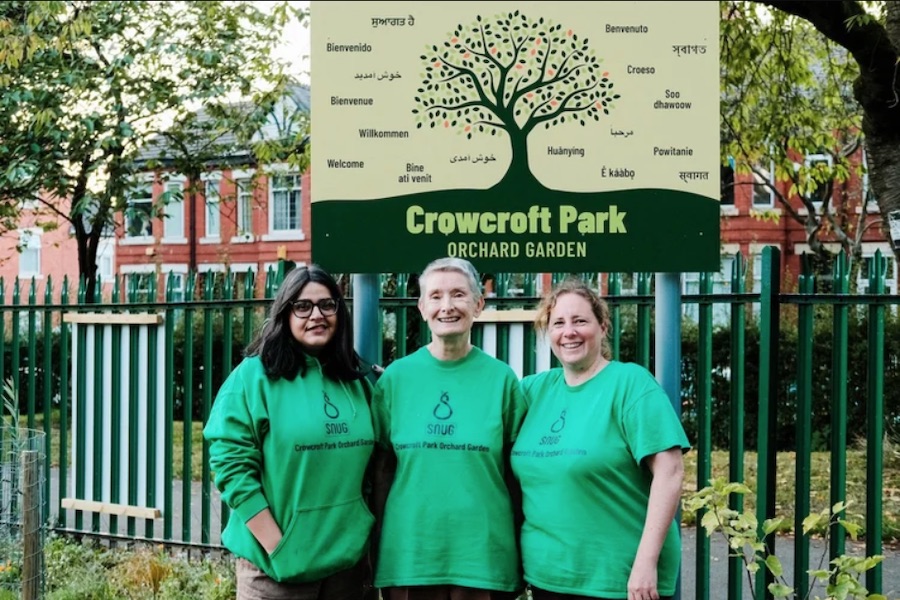 SNUG Garden Manchester
SNUG Garden Manchester
SNUG (Sustainable Northmoor Urban Greening) reclaimed a neglected bowling green in Longsight, creating a forest garden with 54 fruit trees and culturally appropriate planting. Kieron said: “This is an area with high levels of poverty, a large South Asian Community with some issues around cohesion, litter – all the usual challenges. But the project here is doing wonders in bringing people together.”
The site, based on an old Bowling Green in the community, which has now been turned into a forest garden. They’ve planted about 54 different types of fruit trees, using layers of planting called glade beds, which follow forest garden principles. It’s a very different type of growing space. It brings people together, has the added advantage of helping people save money with herbs and fruit available.
They have extended greening into schools, alleyways, and streets, drawing together people of all ages and backgrounds. You can find out more about their work here
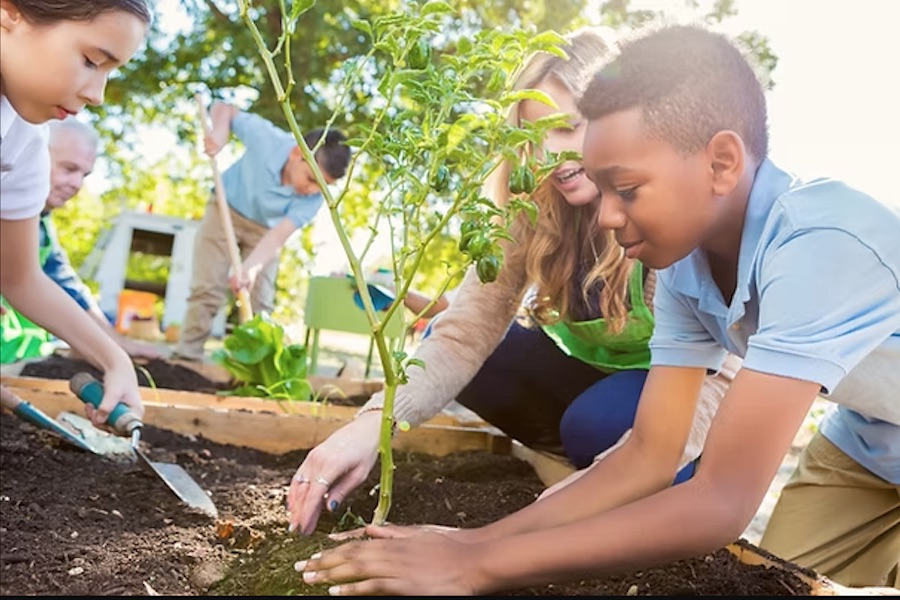 Planting at the Brotherhood Peace Garden
Planting at the Brotherhood Peace Garden
Brotherhood Peace Garden in Moss Side, created by the Brotherhood of the Cross and Star, turned a bare car park into a sanctuary. Supported by the Green Spaces Fund, it offers food growing, workshops on rainwater harvesting and tree planting, and a community kitchen where meals are shared. You can find out more about their work here
There’s so much more that goes on at these places than meets the eye. They reduce isolation, encourage physical activity, teach practical skills, and provide safe spaces for children. They also support biodiversity and climate goals: planting trees, improving soil, and creating pollinator habitats.
“These gardens, done properly, they’re as essential to a community as a GP surgery, library, or post office. They anchor neighbourhoods, build resilience, and create a real sense of belonging,” said Keiron.
“We try to help every step of the way for communities to set up these spaces, with funding, ideas, clearing up, getting volunteers, and running workshops. We also help maintain the space”
What’s the picture like in Manchester’s waterways?
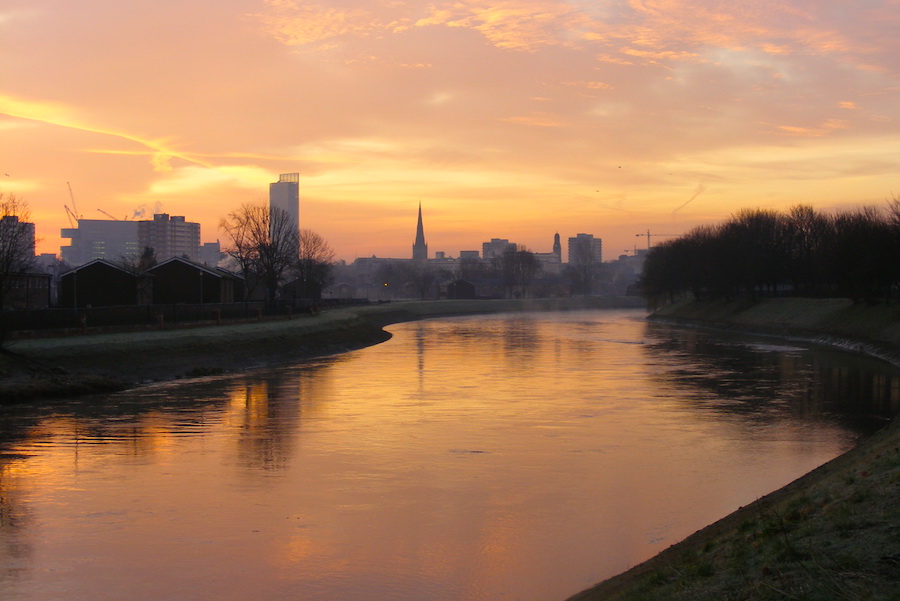 Dawn over the River Irwell
Dawn over the River Irwell
Manchester’s green revival extends beyond gardens. Its rivers tell a story of dramatic decline and hard-won recovery.
The Irwell, Medlock, Irk and Mersey once powered the industrial revolution. But by the 1970s, aquatic life was virtually absent. The Mersey was pronounced biologically dead.
Clean-up efforts since the 1980s have reversed the trend. Today, fish, mayflies, and otters have returned. Otters, once near local extinction, are now breeding in more than half of Manchester’s catchments.
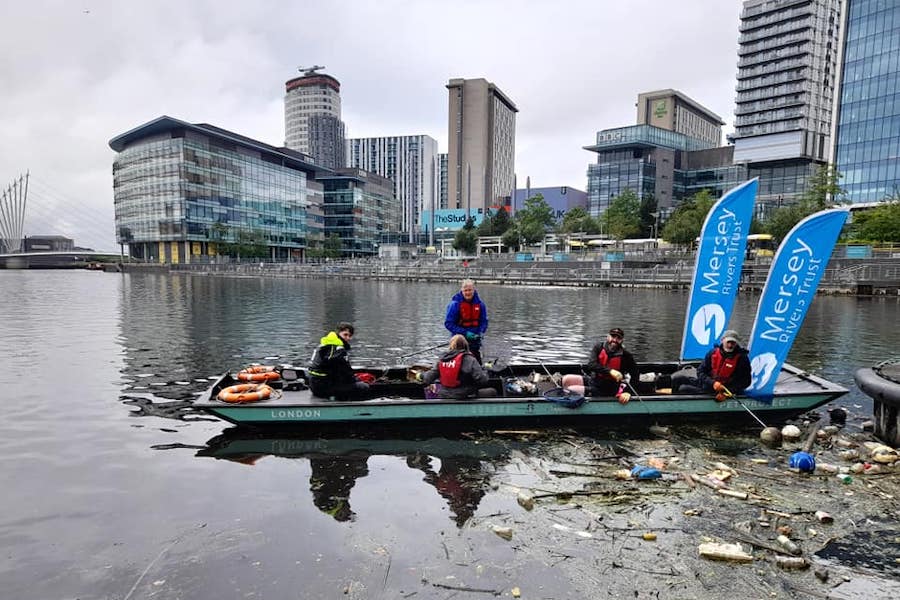 The Litter Boat in Salford Quays
The Litter Boat in Salford Quays
The Mersey Rivers Trust run a litter boat that collected 36,000 litres of litter last year. The purpose built litter boat was purchased with funding from the Healthy Rivers Trust and Salford City Council. Funding from the Environment Agency allows it to operate about once a week along the Irwell between Salford Quays and Manchester Cathedral.
The litter boat is the latest step in the decades long clean-up of the River Irwell, once one of the dirtiest and most polluted in the country. The hugely successful clean-up has seen businesses and residents flock back to the river, with an estimated 48,000 workers and 10,000 residents now living and working in close proximity to it. Around 100,000 pedestrians cross the river on a daily basis.
You can find out more about that here
Yet the recovery is fragile. The LNRS warns: “None of our rivers are classed as in good ecological condition, and 11% remain in poor or bad condition.” More than a thousand barriers, from weirs to culverts, still block the movement of fish and eels.
Perhaps the greatest modern threat comes from the Victorian sewer network. Across Greater Manchester, 793 storm overflows discharge waste into rivers during heavy rain. In 2022, they spilled 21,391 times, for an average of 4.5 hours each. With climate change bringing heavier downpours, the pressure is set to increase.
Investment is planned: United Utilities has committed to upgrading 100 overflows by 2030. But campaigners warn the scale of the challenge is daunting. Defending Manchester’s rivers will require not just infrastructure investment but also citizen vigilance, policy change, and sustained political will.
Woodlands, mosslands and moorlands: the wider green network
Beyond the city’s core, Greater Manchester’s green network expands into woodlands, mosslands, and moorlands. These landscapes are vital for biodiversity, flood resilience, and carbon storage.
Woodlands: Greater Manchester has 11 million trees and a canopy cover of 15%. Since 2017, over 900,000 trees have been planted, coordinated by the charity City of Trees. Yet two-thirds of existing woodland is unmanaged, leaving it vulnerable to disease and decline.
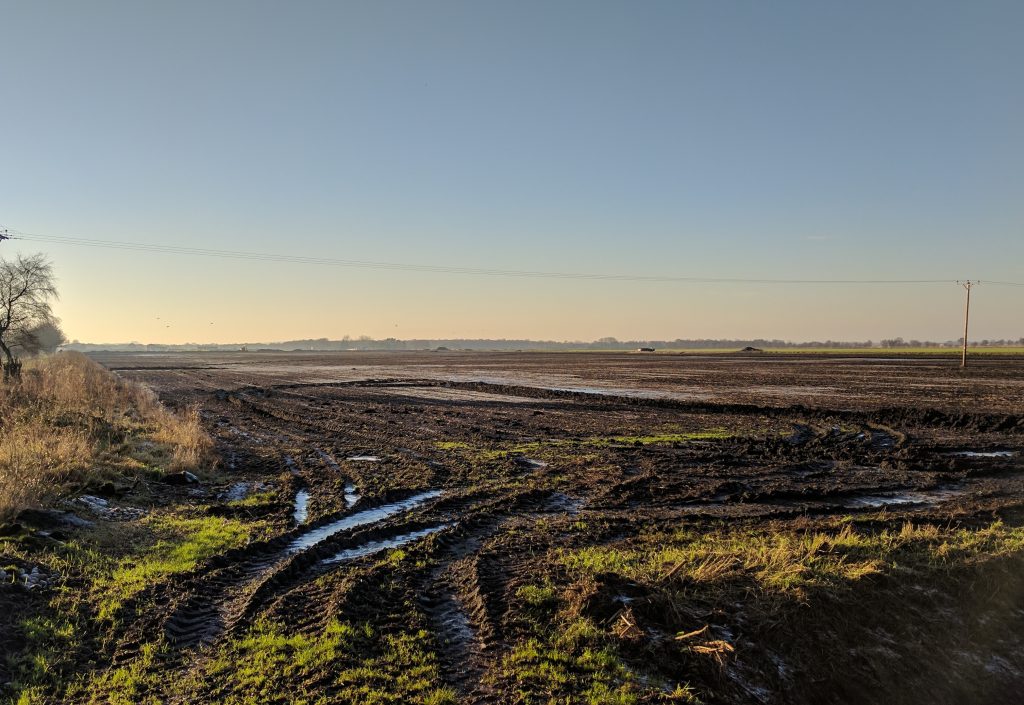 Chat Moss
Chat Moss
Mosslands: Once drained for farming and peat cutting, areas like Chat Moss are now being restored. Rare species such as nightjars and sundews are returning. The Flashes of Wigan and Leigh, designated as a National Nature Reserve, showcase what recovery can look like.
Moorlands: On Saddleworth and Holcombe Moors, projects block drainage gullies, plant sphagnum moss, and stabilise peat. These efforts reduce flood risk downstream and lock carbon in the soil. But the moors remain vulnerable to wildfires, invasive species, and development pressure.
These landscapes remind us that Manchester’s “green” is not confined to parks and rivers. They are part of a regional ecosystem, facing their own battles for survival.
Challenges ahead for Manchester’s green spaces
For all the successes, the LNRS is candid: the work is far from done. Only 5% of Sites of Special Scientific Interest in Greater Manchester are in “favourable condition. Access to green space remains deeply unequal, with disadvantaged communities least likely to live near quality parks. Water pollution from storm overflows and agricultural run-off threatens rivers. Many projects, from orchards to wetlands, depend heavily on volunteers, raising questions about long-term funding and resilience.
Perhaps the greatest challenge is knitting the successes together. The LNRS calls for a joined-up Nature Network to connect habitats, species, and communities. “Mapping our network for nature is just the first step,” it says. “The real prize is in bringing the maps to life by delivering on nature recovery in these areas in harmony with how we grow the city-region.”
“The work is far from done, but everyone can play a part”
What shines through most strongly is that Manchester’s renaissance is not the work of councils alone. The LNRS names a diverse cast of “frontline workers”: local authorities, volunteers, residents, schools, the NHS, developers, businesses, farmers, landowners, environmental charities, and citizen scientists.
The truth is visible on the ground. In Moss Side’s ginnels, in Longsight’s orchards, in Oldham’s canal-side gardens, on the litter boat in Salford quays, people are taking the lead. Their projects may be small in scale, but together they add up to a city redefining its relationship with nature.
Manchester’s green future is being written not only in parks and policies, but in compost heaps, harvest festivals, canal litter-picks, and neighbours planting together. It is proof that when people reclaim land for nature, they also reclaim it for each other.
Find out more about Manchester City Council’s Local Nature Recovery Strategy
You can read Manchester City Council’s Local Nature Recovery Strategy (LNRS) by clicking here
